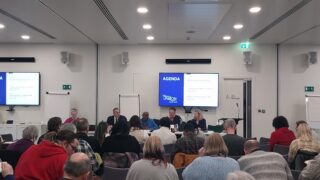Ensuring accessible digital and hybrid meetings and events
UNISON is committed to removing or reducing all barriers to participation. The South East Region has the led the way in this through our Working Together Guidelines, Access Standards and Disability Access Passport. It’s vitally important that we continue to ensure all our on-line meetings are accessible to all members, and everyone can participate fully.
These must be used for all virtual meetings and events, and our Working Together Guidelines will continue to apply.
Along with the information below, we’ve put together these access standards for digital and hybrid meetings with everything about what to expect at these meetings.
General and technical guidelines
- Click here to watch a video on joining a meeting using Teams
- We’ve also put together this helpful document on how to join a Teams meeting
- Please try and join a few minutes early. If you know you are going to be late, please email the committee administrator in advance.
- When you join the meeting, please ensure your microphone is muted. This will give a better experience for all attendees. Please note participants may also be muted remotely to prevent background noise in the meeting.
- You have the option of turning your webcam on in the tool bar. This is recommended so that all participants can see who else is taking part. Please note that you will not be able to see all attendees at the same time.
- If you may be interrupted during the meeting, let everyone know – as you would in a normal meeting. Remember to ‘mute’ yourself again afterwards.
- If you wish to ask a question or speak, please click the ‘raise hand’ button. If you are using a mobile phone or tablet, then please indicate in the chat function that you wish to speak.
- Wait to be called upon, as you would in a normal meeting, and then unmute yourself. The host should wait a few minutes if asking a question, to give everyone time to speak if they wish. Once you have spoken, please mute your microphone again.
- If you experience poor connection, please hang up from the meeting and reconnect. If you are disconnected you can join using the same button, or via the link provided in the email.
- If you are completely unable to access the meeting, please contact the meeting organiser so that a team member can assist you.
Speakers and Contributors
- Make sure your face is well-lit and can be clearly seen so that members with visual impairments or who lip read can see you.
- Position your webcam roughly in line with your eyes and back it up a little so that there is space around your face and upper body.
- Be aware that light coming from behind you can shadow your face and can be painful for people with a visual impairment. Do not sit in front of a window – if you must then close the blinds or curtains.
- Use a headset or earphones where possible to improve audio quality.
- Choose the option “blur background” in Teams if available, to reduce distraction and allow a clearer image so that neurodiverse members and those with hearing impairments can focus on what you are saying.
- Provide any slides or papers you will be using two weeks in advance so that members with different impairments have time to read and process the contents.
- Slow down your speaking style and create pauses between sections so members who are taking notes, using live captions or sign language interpreters can catch up.
During the meeting
- There will be a “technical and access facilitator” in the meeting to deal with any access issues during the meeting and ensure everyone can participate.
- The technical and access facilitator can use the function “mute all” and ask attendees to mute themselves when not speaking to avoid feedback and distracting background noise that can affect members with hearing impairments.
- Attendees should not speak unless called upon by the Chair; this includes responses back. If attendees are called away from their screen, or there are any distractions in the background, cameras should be switched off so neurodiverse members can focus.
- Ask people speaking to say their name every time they speak, so all attendees know who is talking.
- Microsoft Teams includes the option of live captioning. This can be activated by hovering over the three dots in the toolbar and selecting ‘turn on live captions’.
- Please be aware that the region cannot currently send out any hardcopy paperwork from our offices.
- All paperwork must, therefore, be received in a format that can be accessed on any IT equipment and received at least two weeks in advance. No additional papers or presentations can be referenced or used during meetings.





